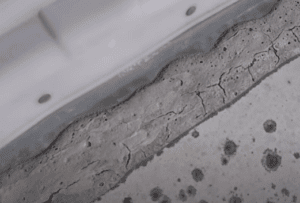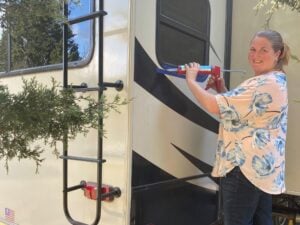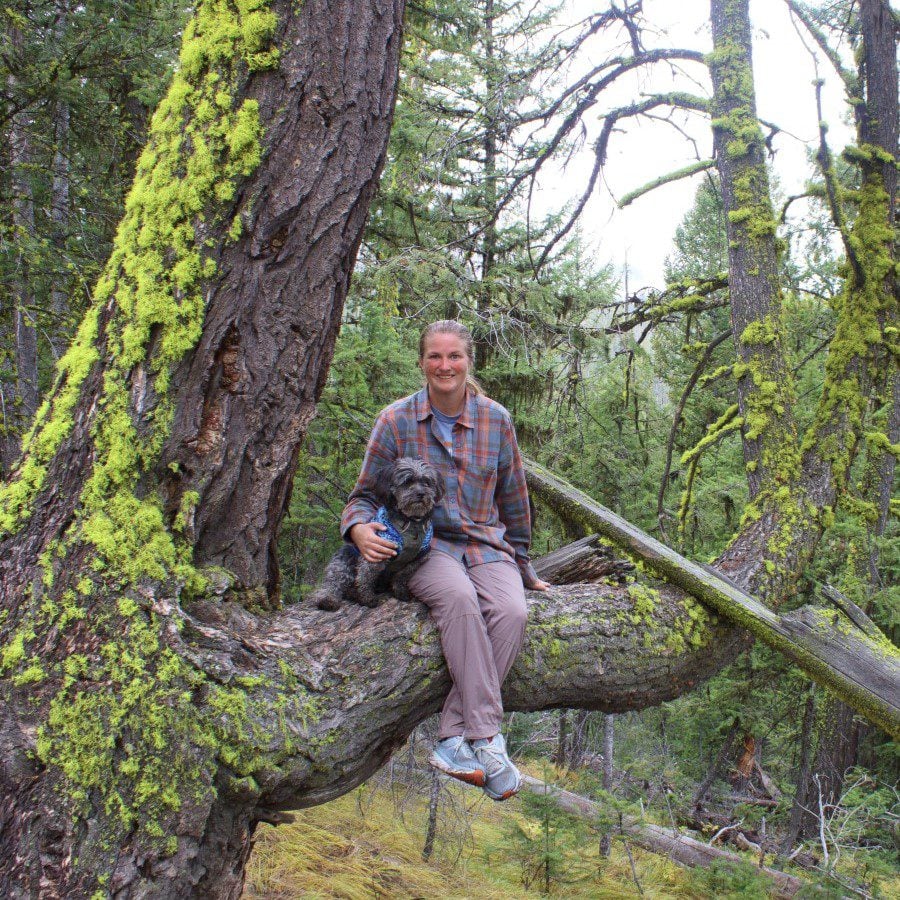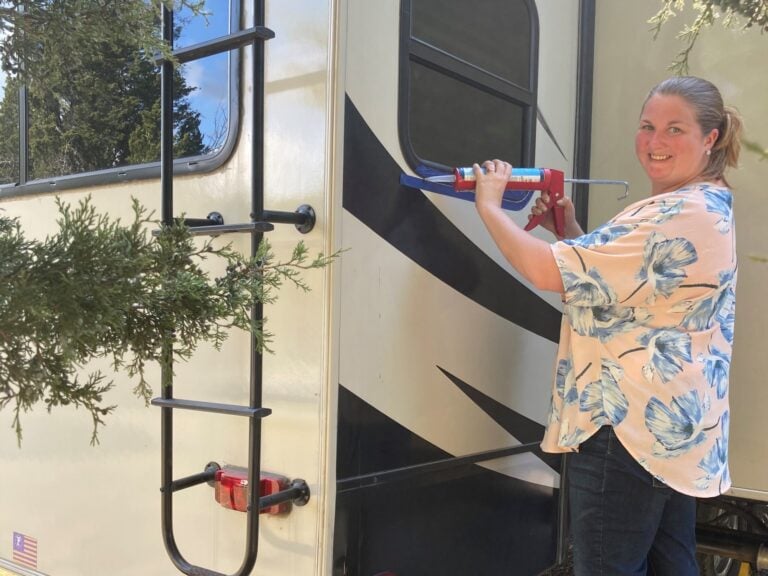This post may contain affiliate links. See our affiliate disclaimer here.
Keeping the seals on your RV’s roof, windows and other exterior edges is the easiest way to keep water out of your RV. However, many RV owners are confused by all of the sealant options available. In this article, we share the best RV sealant brand and the best RV sealant type for each job.
For more step-by-step RV maintenance guides, check out our eBook: The Owner’s Guide to RV Maintenance.
Contents
Best RV Sealant Brand
Let’s start with the sealant brand. My husband is a certified RV technician, and he says Dicor is the best RV sealant brand. Dicor sealant is made specifically for use in RVs and their products are used by many RV manufacturers.
Another reasons we love Dicor’s sealants is they are free of hazardous air pollutants (HAPs). Dicor also produces specific products for each job, so you can use the best RV sealant for each project.
To be clear, this post is not sponsored. We are recommending Dicor’s products because they are what we use on our own RV.
Best RV Sealant for Roof
The best RV sealant to use on roofs is Dicor Self-Leveling Lap Sealant. Lap sealant is a specialty RV caulk used to seal along the roof’s edges, around air vents, vent pipes and screw heads.
Dicor’s lap sealant products are compatible with any roofing material and will adhere to aluminum, mortar, wood, vinyl, galvanized metal and concrete.
Dicor’s lap sealant is UV stabilized to prevent deterioration and discoloration. Plus, it will not stain or discolor any roofing material to which it is applied.
Dicor makes both non-leveling and self-leveling lap sealant products. We recommend the self-leveling sealant because it levels itself after being squeezed out, so you do not need to stop applying and smooth the sealant in with your finger.
The process is faster and cleaner than using a non-leveling sealant. Self-leveling lap sealants only work on horizontal surfaces, and should not be used on vertical edges.
Lap sealants are available in white, black, grey and multiple shades of beige. Make sure to order the color that will match your original roof seals.
Best RV Sealant for Windows and Doors
The best RV sealant to use around windows, doors and other non-roof edges is Dicor Cap Sealant. Their cap sealant is specifically made to seal around perimeters of windows, entry doors, storage bay doors and joints made of bare or repainted materials.
Dicor’s Cap Sealant has many benefits that make it the best product available. This caulk is long-lasting because it is water resistant and UV resistant. It also dries fast and works easily in any standard caulk gun.
Dicor Cap Sealant is available in clear, white, black and tan, so RV owners can select the color that best matches their rig’s exterior design.
How to Apply RV Sealant
While repairing your RV seals is one of the most crucial aspects of RV maintenance, it is an easy process that most RV owners can do without professional assistance. Many experts recommend checking your seals annually or semi-annually.
However, we recommend checking seals every month or, if you are camping infrequently, every time you use the RV. It is important to identify broken seals quickly to prevent water from seeping in cracks.
Always make safety a top priority. Use a telescoping ladder to reach high windows. Only take on a resealing project if you are stable on your feet and feel comfortable climbing on a ladder and your RV’s roof.
How to Apply RV Sealant on the Roof

Step 1: Check for Broken Seals
Visually inspect seals along the roof’s edges, around air vents, vent pipes and screw heads. Look for cracks in the sealant, chipped sealant and areas where the sealant has thinned. Any areas with these visual issues need to be resealed.
Step 2: Remove and Clean Old Lap Sealant
Remove any damaged sealant where the damage would make it difficult to cover. For example if the old lap sealant has bubbled up, remove it using a caulk scraping tool.
Old lap sealant that is just cracked or thinned can be left in place. Thoroughly clean the old sealant and surrounding areas with soap and water. Allow it to dry before proceeding.
Step 3: Apply Sealant
Use our recommended best RV sealant: Dicor Self-Leveling Lap Sealant. Put the sealant tube into a caulk gun, and apply it over the old sealant.
The sealant will be 80% cured after 48 hours, so check the forecast and make sure your RV stays dry for at least two days after application. It takes 30 days to fully cure.
How to Apply RV Sealant around Doors and Window

Step 1: Check for Broken Seals
Visually inspect seals around the entry door, window and storage doors. Look for cracks in the sealant, chipped sealant and areas where the sealant has thinned. Any areas with these visual issues need to be resealed
Step 2: Remove Damaged Sealant
Completely remove the damaged sealant using a caulk scraping tool. The hand tool should be sufficient for regular RV maintenance.
However, if you are resealing an entire RV, an oscillating tool can speed up the process. Thoroughly clean the area where sealant was removed and allow it to dry before proceeding.
Step 3: Apply Painter’s Tape
Apply painter’s tape directly above and below the old sealant line. The tape will help you apply the sealant in a straight line and avoid a messy looking finished product.
Step 4: Apply Cap Sealant
Use our recommended best RV sealant: Dicor Cap Sealant. Put the sealant tube into a caulk gun, and apply the sealant in between the two strips of tape.
Wait three to five minutes and remove the painter’s tape. Make sure the RV stays dry (check the forecast before starting) for at least 24 hours to allow the sealant to fully dry.
FAQs about RV Sealant
What is the best sealant for RV roofs?
The best RV sealant to use on roofs is Dicor Self-Leveling Lap Sealant. Lap sealant is a specialty RV caulk used to seal along the roof’s edges, around air vents, vent pipes and screw heads.
What is the best sealant for RV windows and doors?
The best RV sealant to use around windows, doors and other non-roof edges is Dicor Cap Sealant. Their cap sealant is specifically made to seal around perimeters of windows, entry doors, storage bay doors and joints made of bare or repainted materials.
What is the difference between RV lap sealant and cap sealant?
Lap sealant is used on roof edges and around appliances on the roof. Cap sealant is used around RV doors and windows.
What is self-leveling cap sealant?
Self-leveling sealant spreads out after it comes out of the container, so the sealant will automatically flatten and fill in the area it is applied to. Only use self-leveling sealant on horizontal surfaces.
Understanding proper maintenance is the most important thing for new RV owners to learn.
For more RV maintenance guides and instructions, see our guide to RV water heater maintenance, our guide to RV AC maintenance and our full list of important RV maintenance tips.
Do you have any additional questions about resealing RV seams and edges? Drop your queries in the comments section below.

Christina Pate is a seasoned full-time RVer who, along with her husband Justin, has journeyed across the US, Canada, and Mexico. Drawing from her extensive travels, RV repairs and RV renovations, she founded Travels with Ted to guide and inspire fellow RV enthusiasts. Christina is also the co-author of The Owner’s Guide to RV Maintenance and the creator of My RV Log Book.




Super informative! Thanks for this! Will definitely be referring back whenever we need to do some resealing ??
Have this in our toolbox! It’s so amazing. Thank you for sharing 🙂
You’re so welcome! Thanks for reading
Great post! We recently used Dicor as well, great product ?
It really is the best!
Thank you for this! We were actually planning to look at our RV seals last week and now with your list; I need to check out a few more places than just the seals. Thank you! Sharing with hubs now.
I’m so glad is was helpful! Please reach out if you have any questions.